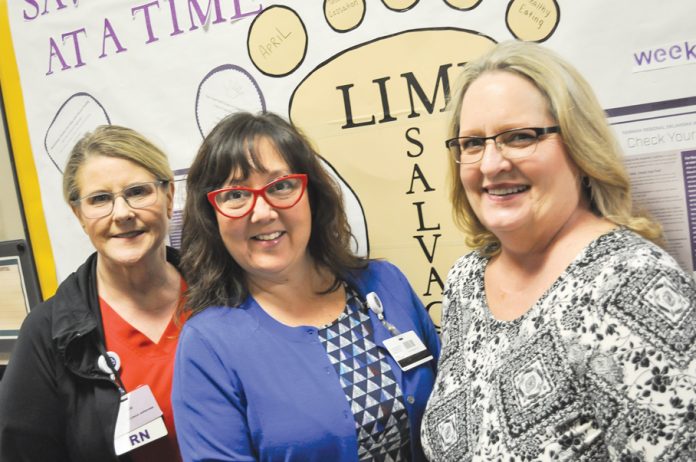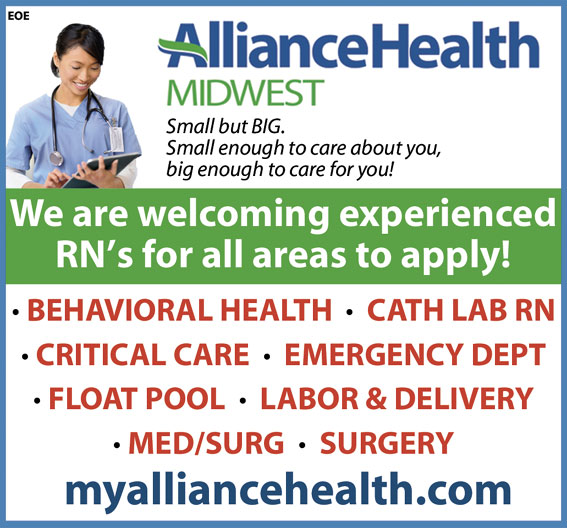
CAREERS IN NURSING
LIFE AND LIMB: NRH A LEADER IN WOUND CARE
by Bobby Anderson – staff writer/photographer
What started as an initiative to reach an underserved inpatient population has grown into the largest wound center in the state.
Norman Regional’s Oklahoma Wound Center is now in its fifth year and Nurse Navigator Karen Ritchie, RN, says it’s literally saving life and limb.
“We saw the need because we found we had inpatients who were falling through the cracks. They had diabetic foot wounds that were not being addressed in the hospital,” Ritchie explained. “They were coming to the wound care clinic weeks later. When they were here it was already a bad enough wound we were talking amputation, hurrying and scurrying around … and hoping we were in time.”
“Had we caught it earlier and done the testing and got the specialists involved quicker we would have a better chance of saving that appendage.”
Dr. Tay Sha Howell has helped spearhead that effort.
Dr. Howell has served as the Wound Care Medical Director for Norman Regional Health System since 2008, covering the Oklahoma Wound Center, the inpatient wound program and the Diabetic Limb Salvage Program.
Howell said educating patients, family members, nurses, doctors and administrators and community members has been key to saving appendages.
“We really need the primary care doctors to recognize the minor wound the patient is not complaining about is a time bomb waiting to explode,” Howell said.
And this month you’ll see her sporting a single white tube sock wherever she goes to bring more attention to Limb Loss Awareness Month.
The picture has historically been bleak in Oklahoma when it comes to the number of amputations per capita. Ritchie said Oklahoma still rates among the top two states in the nation in total below-the-knee and above-the-knee amputations each year.
That’s due in large part to Oklahoma having a higher diabetes rate than the national average (11 percent in Oklahoma compared with 8 percent nationally).
One in 15 diabetic patients will develop a diabetic foot ulcer.
Having a diabetic foot ulcer increases the risk of amputation, especially when combined with smoking, kidney failure, or peripheral artery disease.
What’s more, the death rate at five years for a diabetic foot ulcer is higher than colon cancer or breast cancer.
“We’re still scraping the bottom of the barrel in Oklahoma,” Ritchie said. “Norman Regional’s DLS program is still the only one we know of in the state that is a true DLS program.”
“Our amputation rates have definitely gone down.”
At its core, peripheral artery disease is generally what costs patients a limb.
PAD occurs when arteries in the legs become narrowed or blocked by plaque build-up, reducing blood flow to the limbs.
It affects at least 12 million people in the US and about 95% of PAD patients have at least one other chronic disease, such as diabetes, heart disease, or high blood pressure.
Because this disease is not limited to the legs, patients with PAD are also at greater risk of future heart attack and stroke.
Poor glycemic control and long-term use of insulin can lead to PAD. Diabetics have up to 4 times greater risk of PAD and up to 5 times greater risk of amputation.
Denise Moles, RN, joined the Oklahoma Wound Center as the clinical supervisor with 25 years of nursing experience, including critical care and leadership.
“I did all those high adrenaline situations and it was an adjustment at first but now I’m really liking it,” Moles said. “You’re not saving a life within that first 30 minutes or an hour you’re working on that patient but you’re saving a life for the long run.”
“It starts with a wound or a leg but it’s incredible because you do get to know these patients so well. They look at us like family.”
Diabetic wounds have the potential to get worse quickly. A small sore on the foot or leg could easily end in amputation without the proper care.
“You get a patient who walks through this door and they’re scared, they’re afraid they’re going to lose their limb,” Ritchie said. “You’re explaining their disease process and getting them into specialists. It may take a while, it’s not something we’re going to heal in a couple months. You kind of become family, you get to know them they get to know you.”
“Then one day they walk out of this clinic and they’ve got all their appendages.”
Norman Regional Health System has processes in place to look for patients with diabetic ulcers that could benefit from the Diabetic Limb Salvage Program.
Ritchie educates nurses throughout the system on what to look for and has helped develop order sets that ensure those wounds are addressed in the hospital and eventually at the Oklahoma Wound Center.

Small but BIG.
Small enough to care about you,
big enough to care for you!
We are welcoming experienced RN’s for all areas to apply!
· BEHAVIORAL HEALTH · CATH LAB RN · MED/SURG · EMERGENCY DEPT · CRITICAL CARE · SURGERY · LABOR AND DELIVERY · FLOAT POOL
myalliancehealth.com
EOE











